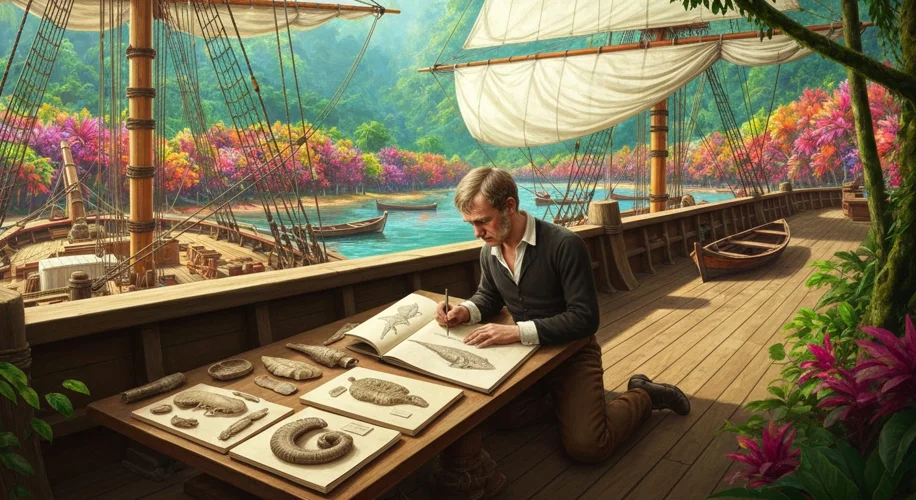The year is 1831. A young Charles Darwin, barely out of Cambridge and plagued by a lingering sense of restlessness, stands on the precipice of an adventure that would forever alter humanity’s understanding of life itself. He was to join the crew of the HMS Beagle, not as a captain or a seasoned naturalist, but as a gentleman naturalist and companion to Captain Robert FitzRoy. It was a voyage destined to span five long years, charting the coasts of South America and beyond, a journey that would transform a contemplative young man into the architect of a scientific revolution.
The world in the early 19th century was a place steeped in tradition and deeply influenced by religious doctrine. The prevailing view of life on Earth was one of divine creation, with species fixed and unchanging since their creation. The idea that life could evolve, that species could change over vast stretches of time, was not only heretical but scientifically unthinkable to most. Yet, Darwin, a keen observer with an insatiable curiosity, was about to be confronted with evidence that would gnaw at the very foundations of this established order.
The Beagle’s mission was primarily cartographical, tasked with surveying the intricate coastlines of South America. However, for Darwin, it was a grand expedition into the unknown. He was a man of privilege, but not one to shy away from hardship. He endured sea sickness, the cramped confines of the ship, and the sheer immensity of the task ahead. His enthusiasm, however, was boundless. He collected specimens with a fervent zeal, from the tiniest insects to the fossilized bones of giant extinct mammals.

The voyage took Darwin to a dizzying array of landscapes. He trekked through the dense rainforests of Brazil, marveling at the sheer diversity of life. He explored the arid plains of Patagonia, where he unearthed the colossal remains of giant ground sloths and glyptodonts, creatures utterly unlike anything alive today. He climbed the Andes mountains, not just observing the geological formations but actively collecting fossils of marine life found at astonishing altitudes, a puzzle that would later ignite his thinking about the Earth’s dynamic nature.
But it was the Galápagos Islands, a volcanic archipelago straddling the equator, that would become the crucible of his revolutionary ideas. Here, Darwin encountered a unique collection of creatures, many found nowhere else on Earth. He observed finches with subtly different beak shapes, each perfectly adapted to the specific food sources available on their respective islands. He noted the distinct shell shapes of giant tortoises, varying from island to island. He saw marine iguanas, the only lizards in the world to swim in the sea, and flightless cormorants.
These observations, seemingly disparate at first, began to coalesce into a powerful, unifying idea. Darwin realized that these subtle variations were not random. They were the result of adaptation, of a struggle for survival where individuals with traits better suited to their environment were more likely to survive and reproduce. Over countless generations, these slight advantages would accumulate, leading to the diversification of species and the emergence of new forms. He was witnessing, in real-time, the slow, inexorable process of evolution by natural selection.
Upon his return to England in 1836, Darwin was no longer the restless young man who had departed. He was a scientist with a wealth of evidence and a theory that challenged the very bedrock of biology. He spent decades meticulously gathering more evidence, conducting experiments, and refining his arguments. The pressure to publish was immense, especially when he learned that Alfred Russel Wallace had independently conceived of a similar theory.
In 1859, Darwin published “On the Origin of Species,” a book that sent shockwaves through the scientific community and beyond. It was a direct challenge to the prevailing belief in creationism, offering a naturalistic explanation for the diversity of life. The book was met with both fierce opposition and enthusiastic embrace. Critics denounced it as blasphemous, while scientists recognized its profound implications.
The impact of Darwin’s work cannot be overstated. His theory of evolution by natural selection provided a unifying framework for all of biology. It explained the relationships between different species, the fossil record, and the geographical distribution of organisms. It laid the groundwork for genetics, paleontology, and evolutionary biology, fields that continue to expand our understanding of life on Earth.
Darwin’s voyage on the Beagle was more than just a scientific expedition; it was a journey into the heart of life’s grand narrative. It was a testament to the power of observation, the courage to question established dogma, and the profound insights that can arise from daring to explore the unknown. The echoes of that five-year voyage continue to resonate today, a constant reminder of our interconnectedness with the natural world and the remarkable, ongoing story of life’s evolution.

